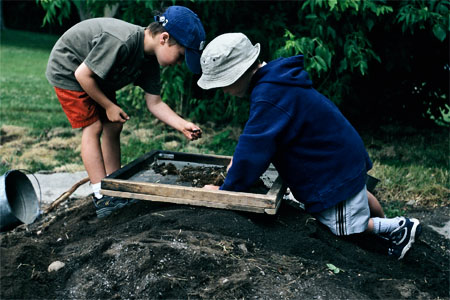 The 2000 Archaeological excavations of Fort Henry’s Garrison Hospital had 67 “Can You Dig It?”© participants and 8 Focus Program students, and ran from July to September. The site was located the east side Point Henry, near the St. Lawrence River shoreline. Three discrete locations were investigated in 2000: the general vicinity of the hospital structure, the Guard House structure and immediate vicinity, and the location of the Dead House. The objective of this year’s excavation was to obtain information on the c.1828-1924 hospital and its adjacent areas. The nature of archaeological resources at Fort Henry in general remained largely unknown at the time of these excavations. Aside from salvage archaeology conducted in 1994 and 1995, no other archaeology had been conducted anywhere on the site until this year’s excavations. This was amazing considering the importance of Fort Henry in Kingston’s cultural history and its status as a National Historic Site.
The 2000 Archaeological excavations of Fort Henry’s Garrison Hospital had 67 “Can You Dig It?”© participants and 8 Focus Program students, and ran from July to September. The site was located the east side Point Henry, near the St. Lawrence River shoreline. Three discrete locations were investigated in 2000: the general vicinity of the hospital structure, the Guard House structure and immediate vicinity, and the location of the Dead House. The objective of this year’s excavation was to obtain information on the c.1828-1924 hospital and its adjacent areas. The nature of archaeological resources at Fort Henry in general remained largely unknown at the time of these excavations. Aside from salvage archaeology conducted in 1994 and 1995, no other archaeology had been conducted anywhere on the site until this year’s excavations. This was amazing considering the importance of Fort Henry in Kingston’s cultural history and its status as a National Historic Site.
By 1828, the Fort Henry Garrison Hospital was built on the east side of the river to complement the army’s Regimental or General Hospital, which was located in the town. Its purpose was to serve the artillery and infantry detachments barracked at Fort Henry, on the east side of the Cataraqui River. It was situated at some distance from the garrison barracks it served, and it was isolated from the surrounding community by a palisade and guardhouse sentry. The isolated hospital site may in fact be reflected its purpose, that of providing isolation from disease on contagion.
When the British garrison marched out in 1870, a permanent Canadian militia was created. Its small size meant the Garrison Hospital became redundant, and it was converted to barracks. It was ultimately abandoned and remained so through the early decades of the 20th century - occasionally visited by RMC cadets on field exercise. At some point the Dead House was demolished. The hospital property was leased by the Department of Militia and Defense to civilians who rapidly populated the shoreline from Cartwright’s Point to Fort Henry with cottages. The stone guardhouse was used by cottagers, but the hospital building itself remained derelict, visited occasionally by transients, and in November 1924 the hospital was destroyed by fire. During the reconstruction of Fort Henry in the mid 1930s the hospital ruins were surveyed with the apparent intention of including it in the overall historic reconstruction, however with the outbreak of WWII and Fort Henry being used as an internment camp, the fire gutted garrison hospital was deemed a nuisance building and demolished.
Little information on the 19th century occupation was discovered, while the impacts of the 1936-1938 restoration were noted. Also the impacts of the 1924 fire, cottaging during the first half of the 20th century, and additional changes such as the installation of the parking lot were observed. That is not to say that no interesting artifacts were found. In particular there were: metal roofing directly below a collapsed brick wall and intact evidence of the fire; two Royal Canadian Artillery buttons; and an 1844 Bank of Montreal Half Penny token.

 The 2000 Archaeological excavations of Fort Henry’s Garrison Hospital had 67 “Can You Dig It?”© participants and 8 Focus Program students, and ran from July to September. The site was located the east side Point Henry, near the St. Lawrence River shoreline. Three discrete locations were investigated in 2000: the general vicinity of the hospital structure, the Guard House structure and immediate vicinity, and the location of the Dead House. The objective of this year’s excavation was to obtain information on the c.1828-1924 hospital and its adjacent areas. The nature of archaeological resources at Fort Henry in general remained largely unknown at the time of these excavations. Aside from salvage archaeology conducted in 1994 and 1995, no other archaeology had been conducted anywhere on the site until this year’s excavations. This was amazing considering the importance of Fort Henry in Kingston’s cultural history and its status as a National Historic Site.
The 2000 Archaeological excavations of Fort Henry’s Garrison Hospital had 67 “Can You Dig It?”© participants and 8 Focus Program students, and ran from July to September. The site was located the east side Point Henry, near the St. Lawrence River shoreline. Three discrete locations were investigated in 2000: the general vicinity of the hospital structure, the Guard House structure and immediate vicinity, and the location of the Dead House. The objective of this year’s excavation was to obtain information on the c.1828-1924 hospital and its adjacent areas. The nature of archaeological resources at Fort Henry in general remained largely unknown at the time of these excavations. Aside from salvage archaeology conducted in 1994 and 1995, no other archaeology had been conducted anywhere on the site until this year’s excavations. This was amazing considering the importance of Fort Henry in Kingston’s cultural history and its status as a National Historic Site.